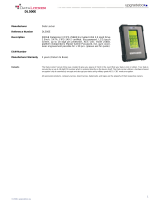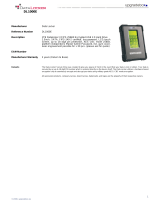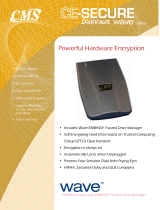
Enterprise Self-Encrypting Drive User’s Guide, Rev. C 17
A similar process is used to change the credential values (passwords) for the Locking SP rather than the Admin SP,
however a look at Figure 10 will show that there are some additional parameters that need attention with BandMas-
terX.
The ReadLockEnabled and WriteLockEnabled parameters do not lock the data band in question, they merely enable the
locking mechanism and allow the parameter LockOnReset to be effective. When this parameter is set to PowerCycle,
the data band will lock automatically when power is removed and reapplied.
Though not shown here, the drive can also be locked and unlocked by setting the parameters ReadLocked and
WriteLocked to TRUE or FALSE.
One further point, the ReadLockEnabled and WriteLockEnabled parameters must be set as a pair such that they must
both be TRUE or they must both be FALSE. The drive will ignore any attempt to set a TRUE/FALSE or FALSE/TRUE combi-
nation. The same applies to the ReadLocked/WriteLocked pair.
In an Enterprise application, the assumption is made that the operating environment is secure and that band locking
is only really required when the drive is removed from its cabinet (causing loss of power). Failure to ensure that the
data band will lock on a power cycle allows access to user data following removal of the drive from its system enclo-
sure.
If there is any suspicion of malicious activity during normal operation of the drive, the ReadLocked/WriteLocked pair
can be used to lock and unlock the data band as required.
2.9 TCG Enterprise Initialization and Restrictions to Operate in FIPS Mode
SEDs intended to operate in a FIPS 140 compliant manner must be set up and operated according to a set of
operating rules. The core functionality of a FIPS drive follows the instructions set forth in this user guide for an SED,
with the following security rules for initialization and operation of the CM in a FIPS 140 Approved manner. Reference
the appropriate sections of the Seagate Security Policy associated with the CERT # for the target device to ensure FIPS
mode compliance, publicly available on the NIST website for validated cryptographic modules:
(https://csrc.nist.gov/projects/cryptographic-module-validation-program/validated-modules/search).
2.9.1 Secure Initialization
1. At installation and during periodic use, examine the physical security mechanisms for tamper evidence.
Seagate SED FIPS drives contain tamper evident labels on the top cover of the hard drive/solid state drive
and may contain a tamper evident label on the PCBA (if the drive has an exposed PCBA).
2. To initiate communication to the SED, take note of whether a SATA or SAS drive is being set up for FIPS
use. If using a SATA device and ATA protocol is supported, transition to the desired mode by performing
one of the following operations:
a. ATA Enhanced Security Mode: User set PIN
b. TCG Security Mode: Authenticates to the Locking SP as BandMaster 0, BandMaster 1, or EraseMaster.
3. For a CM that supports SCSI protocol on the SAS interface, only TCG Security Mode can be used:
a. Transition to TCG Security Mode by authenticating to Locking SP as BandMaster 0, BandMaster 1, or
EraseMaster.
4. Password restrictions in FIPS Mode require CO's and Users to set all operator PINs to private values of at
least 4 bytes (32 bits) in length:
a. In ATA Enhanced Security Mode this applies to Master and User (Drive Owner is optional).
b. In TCG Security Mode, this applies to the Drive Owner SID, EraseMaster, and BandMasters
5. The Makers authority must be DISABLED by the Drive Owner at Installation.
6. At installation, the value of LockOnReset for firmware download must be set to "Power Cycle" and it must
not be modified.
7. At installation, the value of PortLocked for firmware download must be set to "TRUE".
At the end of these steps, the CM will be in FIPS Approved Mode of operation. This can be verified with Show Status
service.

























